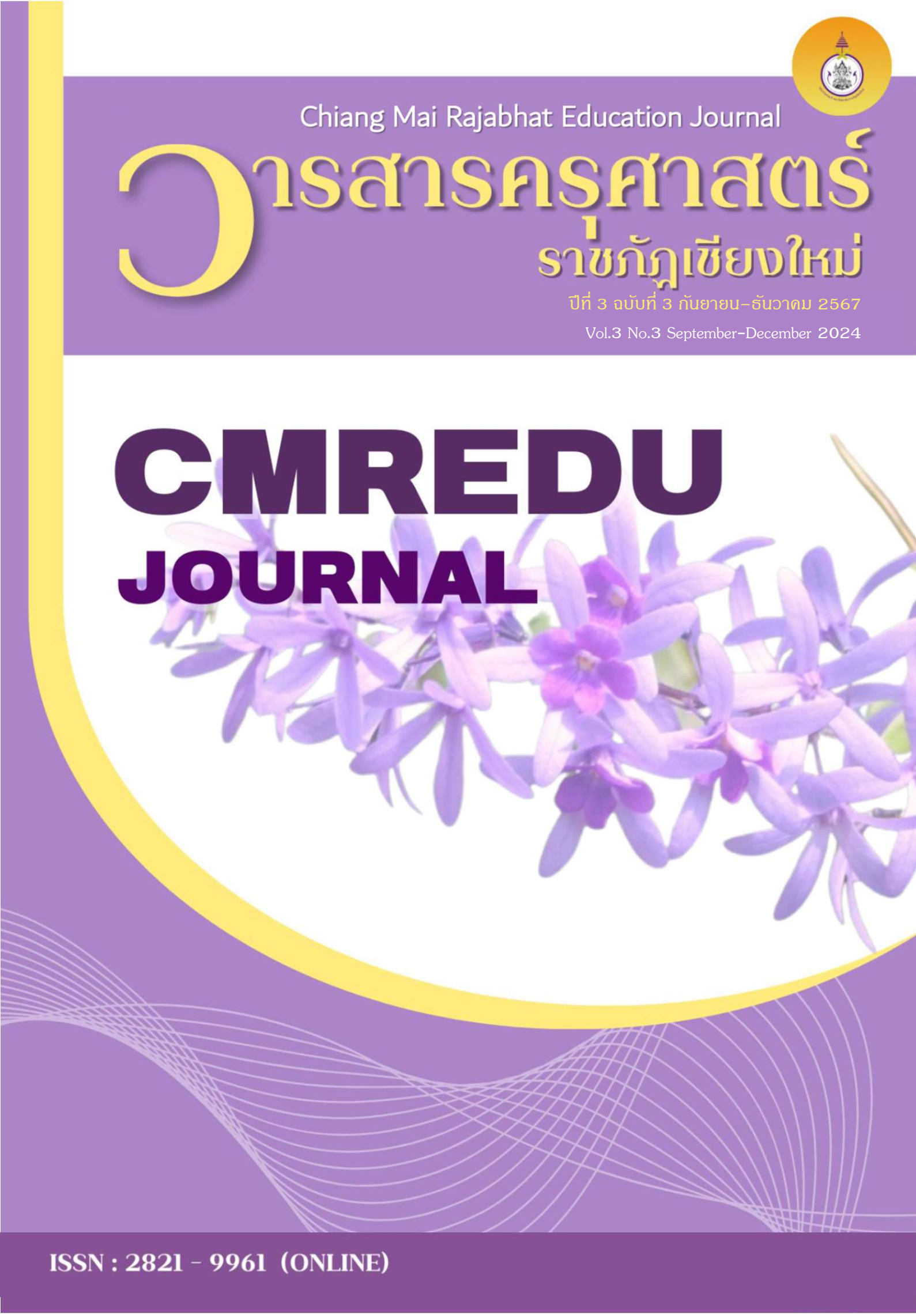Learning Management by Using 5 Steps Learning Process together with Polya’s Problem-Solving Process for Develop the Mathematical Problem-Solving Ability of Lower Secondary Education Level Grade 7 Students
Keywords:
Learning Management, 5 Steps Learning Process together with Polya’s Problem-Solving Process, The Mathematical Problem-Solving AbilityAbstract
The objectives of this research were to 1) create and evaluate the propriety of learning management plan on linear equation with one variable topic by using 5 steps learning process together with Polya’s problem-solving process, and 2) study the mathematical problem-solving ability on linear equation with one variable topic by using 5 steps learning process together with Polya’s problem-solving process. This research employed an action research design.. The sample was Grad 7 class with 20 students from Watbuakkrognua School, Saraphi District, Chiang Mai Province, during the second semester of the 2023 academic year. The sample was selected using a cluster sampling method. The research instruments were 1) learning management plan on linear equation with one variable topic by using 5 steps learning process together with Polya’s problem-solving process, 2) assessment form of learning management plan, 3) the subjective test of mathematical problem-solving ability on linear equation with one variable topic, and 4) the process-based assessment form of mathematical problem-solving ability on linear equation with one variable topic. The statistics used to analyze the data were mean, standard deviation, mode and t-test.
The research results showed that 1) 10 Learning management plans on linear equation with one variable topic by using 5 steps learning process together with Polya’s problem-solving process were rated at the highest level 2) Most students had the mathematical problem-solving ability on linear equation with one variable topic at a very good level and The t-test analysis showed that the post-test scores were significantly higher than the pre-test scores at the 0.01 significance level.
Downloads
References
กระทรวงศึกษาธิการ. (2560). ตัวชี้วัดและสาระการเรียนรู้แกนกลาง กลุ่มสาระการเรียนรู้คณิตศาสตร์ (ฉบับปรับปรุง พ.ศ. 2560) ตามหลักสูตรแกนกลางการศึกษาขั้นพื้นฐานพุทธศักราช 2551. (พิมพ์ครั้งที่ 4). โรงพิมพ์ชุมนุมสหกรณ์การเกษตรแห่งประเทศไทย จำกัด.
ณิชาพร เจริญวานิชกูร. (2560). ผลการจัดกิจกรรมการเรียนรู้คณิตศาสตร์ที่เน้นแบบอย่างและกลวิธีตามเเนวคิดของเมย์เนสและจูเลียน-ชูลต์ที่มีต่อความรู้ทางคณิตศาสตร์และความสามารถในการแก้ปัญหาทางคณิตศาสตร์ของนักเรียนชั้นมัธยมศึกษาปีที่ 5. [วิทยานิพนธ์ปริญญาครุศาสตรมหาบัณฑิต]. จุฬาลงกรณ์มหาวิทยาลัย.
นัฐนันนท์ เต็มศรี และอนุวัตร จิรวัฒนพาณิช. (2564). การศึกษาผลสัมฤทธิ์ทางการเรียนและความสามารถในการแก้ปัญหาทางคณิตศาสตร์ จากการจัดการเรียนรู้โดยใช้กระบวนการเรียนรู้ 5 ขั้นตอน (5STEPs) ของนักเรียนชั้นมัธยมศึกษาปีที่ 6 โรงเรียนเฉลิมพระเกียรติสมเด็จพระศรีนครินทร์ ภูเก็ต ฯ. การบูรณาการสหวิทยาการเพื่อการพัฒนาท้องถิ่น. การประชุมวิชาการระดับชาติ มหาวิทยาลัยราชภัฏภูเก็ต ครั้งที่ 13 (น.1-12). มหาวิทยาลัยราชภัฏภูเก็ต
นิธินันท์ กลั่นคูวัฒน์. (2559). ผลการจัดการเรียนการสอนแบบ TAI รวมกับกระบวนการแก้ปัญหาของโพลยาที่ส่งผลต่อความสามารถในการแก้ปัญหาและผลสัมฤทธิ์ทางการเรียนคณิตศาสตร์ เรื่อง การแกัโจทย์สมการเชิงเส้นตัวแปรเดียว ของนักเรียนชั้นมัธยมศึกษาปีที่ 2. [วิทยานิพนธ์การศึกษามหาบัณฑิต]. มหาวิทยาลัยบูรพา.
ปิยะฎา สิทธิศักดิ์, อนุวัตร จิรวัฒนพาณิช และเจษฎา สุจริตธุรการ. (2565). การศึกษาผลสัมฤทธิ์ทางการเรียนคณิตศาสตร์และความสามารถในการแก้ปัญหาทางคณิตศาสตร์จากการจัดการเรียนรู้โดยใช้กระบวนการเรียนรู้ 5 ขั้นตอน (5 STEPs) ของนักเรียนชั้นมัธยมศึกษาปีที่ 1 โรงเรียนเฉลิมพระเกียรติสมเด็จพระศรีนครินทร์ ภูเก็ต จังหวัดภูเก็ต. การประชุมหาดใหญ่วิชาการระดับชาติและนานาชาติ ครั้งที่ 13 (น.1516-1529). มหาวิทยาลัยหาดใหญ่.
พิชญ์สินี ชมภูคำ. (2565). การวิจัยหลักสูตรและการสอน . คณะศึกษาศาสตร์ มหาวิทยาลัยฟาร์อีสเทอร์น เชียงใหม่.
พิมพันธ์ เดชะคุปต์. (2557). การจัดการเรียนรู้ในศตวรรษที่ 21. โรงพิมพ์แห่งจุฬาลงกรณ์มหาวิทยาลัย.
รัตนะ บัวสนธ์. (2563). การวิจัยและพัฒนานวัตกรรมการศึกษา. (พิมพ์ครั้งที่ 4). โรงพิมพ์แห่งจุฬาลงกรณ์มหาวิทยาลัย.
โรงเรียนวัดบวกครกเหนือ. (2565). รายงานผลการทดสอบทางการศึกษาระดับชาติ O-NET ปีการศึกษา 2565.
วรางคณา สำอางค์, พรชัย ทองเจือ และผ่องลักษม์ จิตต์การุญ. (2560). การพัฒนาความสามารถในการแก้โจทย์ปัญหาคณิตศาสตร์ของนักเรียนชั้นประถมศึกษาปีที่ 6 โดยการจัดการเรียนรู้ ตามแนวคิดของโพลยา. วารสารมนุษยศาสตร์และสังคมศาสตร์บัณฑิตวิทยาลัย มหาวิทยาลัยราชภัฏพิบูลสงคราม, 11(1), 52-61.
สถาบันส่งเสริมการสอนวิทยาศาสตร์และเทคโนโลยี. (2555). การวัดผลประเมินผลคณิตศาสตร์. ซีเอ็ดยูเคชั่น จำกัด.
K R Daulay and I Ruhaimah. (2019). Polya theory to improve problem-solving skills. Journal of Physics: Conference Series, Vol.1188, The Sixth Seminar Nasional Pendidikan Matematika Universitas (pp. 1-6). https://iopscience.iop.org/article/10.1088/1742-6596/1188/1/012070/pdf
Polya, G. (1957). How To Solving it : A New Aspect of Mathematical Method. Doubleday and Company.

Downloads
Published
How to Cite
Issue
Section
License
Copyright (c) 2024 Chiang Mai Rajabhat Education Journal

This work is licensed under a Creative Commons Attribution-NonCommercial-NoDerivatives 4.0 International License.
Journal of TCI is licensed under a Creative Commons Attribution-NonCommercial-NoDerivatives 4.0 International (CC BY-NC-ND 4.0) licence, unless otherwise stated, Please read our Policies page for more information on Open Access, copyright and permissions.





